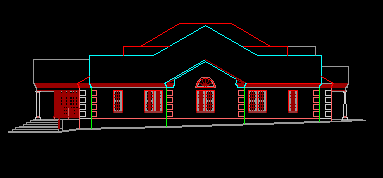
Sheridan College
Architectural Technology
CADD12384 - Architectural Drafting 2 - CADD
Exercise 5 - Importing AutoCAD drawings into Photoshop
The following exercise will demonstrate how to import an AutoCAD drawing into Photoshop.
Method 1: Using Cut and Paste
A. Open the drawing ELEVATION-PHOTOSHOP. (click or shift-click on the link, save it to the D:\USER folder, then open the drawing in AutoCAD).
B. To export the drawing to Photoshop using copy and paste, we can use the view of the elevation as it is in modelspace - however this is not recommended as the different lines (colours) in the view will export as coloured lines.

Instead you should:
- Click on Layout 1. Set the printer to "none" (if we will use cut and paste to transfer the drawing to Photoshop, we will not have to print it), then set the Plot style to "monochrome.ctb" and make sure the "Display plot styles" checkbox is checked.
- The viewport should appear in the layout with the elevation in monochrome (black and white).
- If you have a black background configured for your layout, you should switch back to a white background. Go to Options/Display/Colors and correct this.
You are now ready to copy the elevation view into Photoshop.
C. Open Adobe Photoshop, and start a new image with the desired size. (in this case, use a 640x480 size image with 72 dpi resolution). Make the background transparent. Zoom 100% (full size), and adjust the image borders until the full image is visible on screen.
D. Switch back to AutoCAD, and zoom in/out on the layout in paperspace until the viewport is the approximate same size as the blank image area in Photoshop. Switch to modelspace, and zoom/adjust the elevation in the modelspace viewport until it is the desired size. Press CTRL-C (or select Edit/Copy), then select all the objects in the elevation that you wish to copy to photoshop.
E. Switch back to Photoshop, create a new layer called outline, and paste the contents of the clipboard (the elevation) onto this layer.
Method 2: Using AutoCAD Plot
The above cut and paste method is perfect for creating small drawings (drawings that are smaller than the screen size), but it cannot be used to create large size or high resolution bitmaps. For example, the above image created was 640x480 at 72 dpi, which makes it approx. 8.8" x 6.7". If we wanted to create the same size image for a printer, assuming a resolution of 200 dpi, we would need an image size of 1760x1340 pixels! The cut and paste method will not work for an image this size.
Instead, we can configure AutoCAD to plot to a raster file (BMP or TIFF file).
A. Open the drawing ELEVATION-PHOTOSHOP. (click or shift-click on the link, save it to the D:\USER folder, then open the drawing in AutoCAD).
B. Go to File/Plotter Manager, and examine the printers configured. If there is no Bitmap printer configured, double-click on "Add a plotter wizard" and follow the steps below:
C. The plotter is now set up. You can activate the layout:
You are now ready to plot the elevation view to a file. You can then open the file in Photoshop.
Note: Plotting to a JPG file is NOT recommended. JPEG images use a special lossy compression which will lower the quality of the image. JPEGs are excellent as a final image to be placed on the web, but in our case editing them can be harder than editing a similar TIFF or BMP file.